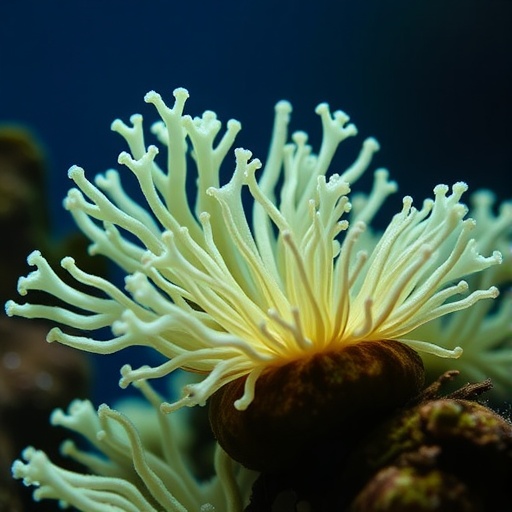In a groundbreaking study published in the journal Coral Reefs, researchers have investigated a significant outbreak of Symbiodinium necroappetens, a symbiotic dinoflagellate, within Southwestern Atlantic corals. This phenomenon follows a notable bleaching event and raises critical concerns about the resilience of coral ecosystems, as well as the potential long-term impact on coral health and biodiversity. The implications of this study are profound, offering a glimpse into the complex interactions between environmental stressors and coral symbionts.
The research team, led by Villela et al., undertook a comprehensive examination of the outbreak, focusing on how S. necroappetens became a predominant symbiont under conditions where other types typically thrive. Following the bleaching event, which occurred due to elevated sea temperatures, the study revealed an increase in S. necroappetens populations, raising questions about the potential for this species to dominate in the wake of coral stressors. Such an ecological shift could have cascading effects on the overall health of coral reefs.
Traditionally, corals rely on a diverse range of symbiotic dinoflagellates to support their metabolic functions through photosynthesis. However, the proliferation of S. necroappetens points to a potential shift in symbiotic relationships fostered by environmental perturbations. This shift may disrupt nutrient flow and energy dynamics within coral ecosystems, opening the door to altered growth patterns and overall resilience in these marine habitats.
The authors meticulously document how the outbreak progressed over time, elaborating on the physiological responses of corals harboring S. necroappetens. The corals displayed varying levels of stress and adaptation, showcasing the resilience often observed in these marine organisms, yet raising alarms due to the uncharacteristic dominance of this specific symbiont. This shift can be unfavorable; coral resilience often hinges on maintaining a healthy symbiotic diversity to withstand changing environmental conditions.
One intriguing aspect of the research is the method of tracking S. necroappetens populations. Using advanced molecular techniques, the researchers were able to discern shifts in genetic expression and identify characteristic markers of this particular symbiont. By employing these techniques, Villela et al. provided a more nuanced understanding of how environmental stressors can catalyze shifts in symbiotic dynamics, effectively tracking the evolutionary responses within coral ecosystems post-bleaching.
The findings draw attention not only to the resilience of coral reefs but also to their vulnerabilities. The study indicates that while some corals may initially survive bleaching events, the long-term effects of an invading species could lead to localized extinctions of various coral types if left unchecked. This potential threat underscores the crucial need for ongoing monitoring of reef ecosystems, especially in light of climate change, which continues to escalate environmental stress.
As the ocean warms and storms become more intense due to climate change, the frequency of coral bleaching events is expected to rise. Understanding the nuanced changes in symbiotic relationships will be essential for reef conservation strategies, as management efforts must incorporate knowledge of how specific symbionts, like S. necroappetens, respond to acute stressors. This study highlights the need for an integrative approach in coral reef management, focusing not only on direct threats but also on the health of symbiotic systems that sustain these ecosystems.
Furthermore, the emergence of S. necroappetens raises broader ecological questions about coral health and biodiversity. The study elucidates the delicate balance existing within coral communities, where the introduction or proliferation of one species may threaten the overall health of coral populations. This call to action smells of urgency, emphasizing the need for continued research in order to unveil the intricacies of coral-symbiont interactions amidst the ongoing climate crisis.
The implications of the findings extend beyond immediate coral community health; they touch on broader ecological relationships and the functionalities these reefs provide, such as coastal protection and habitat for diverse marine species. By elucidating the role of S. necroappetens, this research lays a framework for future studies aimed at deciphering complex ecological dynamics in changing environments.
Notably, the research underlines the importance of predictive modeling to anticipate symbiotic shifts in coral reefs as global temperatures continue to change. Such proactive measures can help scientists and conservationists identify at-risk communities and proactively develop strategies to mitigate adverse outcomes. Importantly, understanding how symbionts respond to stressors can open up pathways for innovative reef restoration efforts aimed at boosting coral resilience.
In conclusion, Villela et al.’s research contributes to a growing body of knowledge surrounding coral reef ecosystems and the physiological and ecological ramifications of climate change. Through their meticulous documentation of Symbiodinium necroappetens, the authors have initiated a vital conversation on the future of coral reefs in a warming world. This story of resilience intertwined with vulnerability serves as a compelling reminder to the scientific community and policymakers: immediate and concerted action is essential to safeguard these invaluable marine resources before irreversible changes take place.
Through understanding the implications of these symbiotic changes, we can better prepare for the future challenges coral reefs will face. Comprehensive strategies that include leveraging scientific insights from studies like this one will be crucial in our initiative to protect coral ecosystems from the current and impending climate crises. The fascinating and complex relationship among coral species and their symbionts continues to unveil intriguing avenues for exploration and discovery, making it imperative that we pay attention to these crucial marine habitats.
Subject of Research: The outbreak and persistence of Symbiodinium necroappetens in Southwestern Atlantic corals post-bleaching.
Article Title: Symbiodinium necroappetens outbreak and persistence in Southwestern Atlantic corals following a bleaching event.
Article References:
Villela, L.B., Aiube, Y.R.A., Silva-Lima, A.W. et al. Symbiodinium necroappetens outbreak and persistence in Southwestern Atlantic corals following a bleaching event. Coral Reefs 44, 1433–1438 (2025). https://doi.org/10.1007/s00338-025-02685-y
Image Credits: AI Generated
DOI: https://doi.org/10.1007/s00338-025-02685-y
Keywords: Coral Reefs, Symbiodinium necroappetens, bleaching events, coral resilience, marine ecosystems, climate change, symbiotic relationships, biodiversity.




